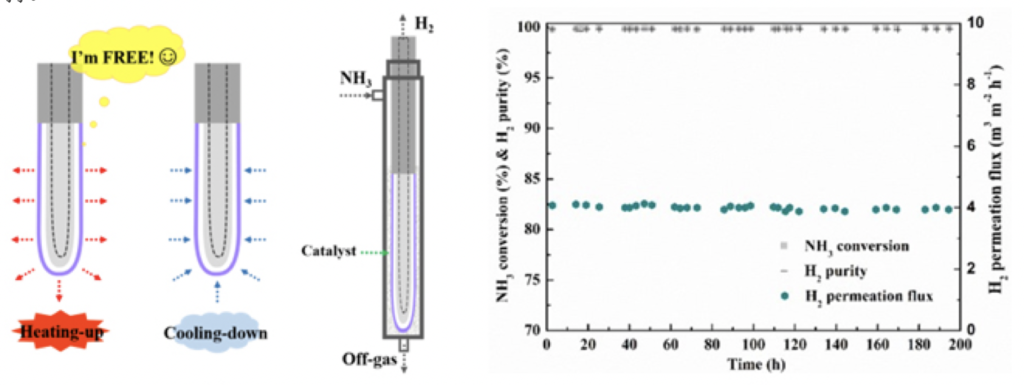CAS Dalian Institute of Chemical Physics develops Pd composite membrane for ammonia to hydrogen fuel cells
Researchers at the CAS DICP have developed a stainless steel reactor with a palladium composite membrane which allowed ammonia decomposition to hydrogen under long-term stable operation for 2000 h. Combination with an ammonia decomposing Ru/MgO catalyst in a membrane reactor reduced the temperature for complete ammonia decomposition from above 748 K to 673 K at stable operation for 200 h.
CAS news release, February 13, 2020

China emphasizes clean coal thermal power supply systems
According to a report by the China’s National Energy Board, by October 2018 ultra-low emission coal-fired power generation equipment in China reached over 700 million kW. Due to ultra-low emissions and energy savings, annual emissions of sulfur dioxide, nitrogen oxide...
Xiamen University team develops humanized mouse model for hepatitis B
Previous studies had shown that mesenchymal stem cells from human bone marrow have the potential to differentiate into hepatocyte-like cells in vitro and continue to maintain essential hepatocyte functions after being transplanted into host mouse livers. After HBV...
China attempts to green the Kubuqi desert in Inner Mongolia
Over the past 30 years, planting shrubs and trees led to greening of over 6000 square kilometers of this desert. Carbon sequestration is now 15.4 million tons, water source recharge is 24,376 million cubic meters, and oxygen release about 18.3 million tons. The region...
Metal-free photocatalyst destroys E. coli in water in 30 minutes
A team from Yangzhou University, CAS Institute of Process Engineering and the University of Technology in Sydney has developed a mthod which killed model Escherichia coli under visible-light irradiation within 30 min, by using an edge-functionalized graphitic carbon...
Rail traffic between China and Europe increases strongly
According to a report of China Daily, 6,300 freight trains travelled between China and Europe in 2018, 72% more as compared to 2017. China Daily German edition, February 1, 2019
Jinan announces Quantum Information Science Center
Jinan, capital of Shandong province, has already built one of the largest and most functional commercial quantum communication networks, named "Jinan Quantum Communication Test Network". The city now pushes for a National Institute of Quantum Information...
A catalyst removing CO traces from hydrogen gas may accelerate introduction of hydrogen fuel-cell cars: University of Science and Technology of China
A team around Junling LU has developed a catalyst based on atomically dispersed iron hydroxide on Pt nanoparticles which allows to purify hydrogen fuel efficiently over a temperature range from -75 - +107 C. This PROX -catalyst (for preferential oxidation of CO...
China’s renewable energy generation increased by 12 % in 2018
According to a report by the National Energy Bureau of China, renewable energy capacity increased by 12 % in 2018 and reached 728 million kW. Hydropower capacity increased by 2.5% to 352 million kW, wind power by 12.4% to 184 million kW, solar power by 34% to 174...
China builds 5G base station in Xining, Qinghai province
Xining is a gateway to Tibet and at a level of over 2,000 m. Last April, the provincial government adopted a plan to develop new wireless technologies, such as the 5G network. According to telecommunications companies, 5G technology can narrow the information service...
8000 taxis in Italy accept payment of fares by Alipay
According to the report, the Italian taxi federation URI has accepted payment by Alipay, a subsidiary of the Alibaba group. Chinese customers who visit Italy can now pay in many cities such as Rome, Milan, Florence etc. by their mobile phones. According to a Nielsen...
CAS QIBEBT team prepares modified bacterial cellulose
A research team led by XIAN Mo and ZHANG Haibo from the CAS Qingdao Institute of Bioenergy and Bioprocess Technology has developed a new method for the preparation of modified bacterial cellulose. Using the microorganism Komagataeibacter...
CAS Shanghai Center for Plant Sciences sequences genome of broomcorn millet
Broomcorn millet (Panicum miliaceum L.) was domesticated on the Loess Plateau of Northern China as early as 10,000 years ago. It achieves the highest amount of grains produced with the same amount of water. ZHANG Heng and ZHU Jiankang from CAS Shanghai...
